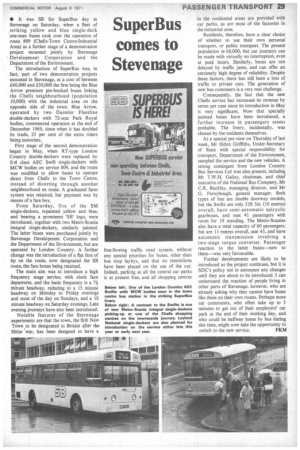SuperBus comes to Stevenage
Page 31

If you've noticed an error in this article please click here to report it so we can fix it.
• It was SB for SuperBus day in Stevenage on Saturday. when a fleet of
striking yellow and blue single-deck one-man buses took over the operation of route 809 (Chells-Town Centre-Industrial Area) as a further stage of a demonstration project mounted jointly by Stevenage ' Development Corporation and the Department of the Environment.
The introduction of SuperBus was, in fact, part of two demonstration projects mounted in Stevenage, at a cost of between £40,000 and 150,000 the first being the Blue Arrow premium pre-booked buses linking the Chells neighbourhood (population 10,000) with the industrial area on the opposite side of the town. Blue Arrow, operated by two Daimler Fleetline double-deckers with 72-seat Park Royal bodies, commenced operation at the end of December 1969, since when it has doubled its trade, 25 per cent of the extra riders being motorists.
First stage of the second demonstration began in May, when RT-type London Country double-deckers were replaced by
S vi class AEC Swift single-deckers with
MCW bodies on service 809, and the route was modified to allow buses to operate direct from Chells to the Town Centre, instead of diverting through another neighbourhood en route. A graduated fares system was retained, but payment was by means of a fare box.
From Saturday, five of the SM single-deckers, repainted yellow and blue, and bearing a prominent `SB' logo, were introduced, together with two Metro-Scania integral single-deckers, similarly painted.
The latter buses were purchased jointly by Stevenage Development Corporation and the Department of the Environment, but are operated by London Country. A further change was the introduction of a flat fare of 6p on the route, now designated the SB route, the fare boxes being retained.
The main aim was to introduce a high frequency stage service, with clock face departures, and the basic frequency is a 74 minute headway, reducing to a 15 minute headway on Monday to Friday evenings and most of the day on Sundays, and a 10 minute headway on Saturday evenings. Late evening journeys have also been introduced. Notable features of the Stevenage experiments are that the town, the firgt New Town to be designated in Britain after the Hitler war, has been designed to have a free-flowing traffic road system, without any special priorities for buses, other than bus stop laybys, and that no restrictions have been placed on the use of the car. Indeed, parking at all the central car parks is at present free, and all shopping centres in the residential areas are provided with car parks, as are most of the factories in the industrial area.
Residents, therefore, have a clear choice of whether to use their own personal transport, or public transport. The present population is. 68,000, but car journeys can be made with virtually no interruption, even at peak hours. Similarly, buses are not delayed by traffic jams, and can offer an extremely high degree of reliability. Despite these factors, there has still been a loss of traffic to private cars. The generation of new bus customers is a very real challenge.
Consequently, the fact that the new Chells service has increased its revenue by seven per cent since its introduction in May is very significant. Now that specially painted buses have been introduced, a further increase in passengers seems probable. The livery, incidentally, was chosen by the residents themselves.
At a special pre-view on Thursday of last week, Mr Eldon Griffiths, Under-Secretary of State with special responsibility for transport, Department of the Environment, sampled the service and the new vehicles. A strong contingent from London Country Bus Services Ltd was also present, includng Mr T.W.H. Galley, chairman, and chief executive of the National Bus Company, Mr C.R. Buckley, managing director, and Mr G. Fernyhough, general manager. Both types of bus are double doorway models, but the Swifts are only 33ft 5in. (10 metres) overall, have semi-automatic epicyclic gearboxes, and seat 41 passengers with room for 19 standing. The Metro-Scanias also have a total capacity of 60 passengers, but are 11 metres overall, seat 45, and have automatic transmission involving a two-stage torque converter. Passenger reaction to the latter buses—new to them—was very favourable.
Further developments are likely to be introduced as the project continues, but it is SD C's policy not to announce any changes until they are about to be introduced. I can understand the reaction of people living in other parts of Stevenage, however, who are
• already asking why they cannot have buses like these on their own routes. Perhaps more car commuters, who often take up to 5 minutes to get out of their employers' car park at the end of their working day, and who could be halfway home by bus during this time, might now take the opportunity to switch to the new service. FKM




























































































































